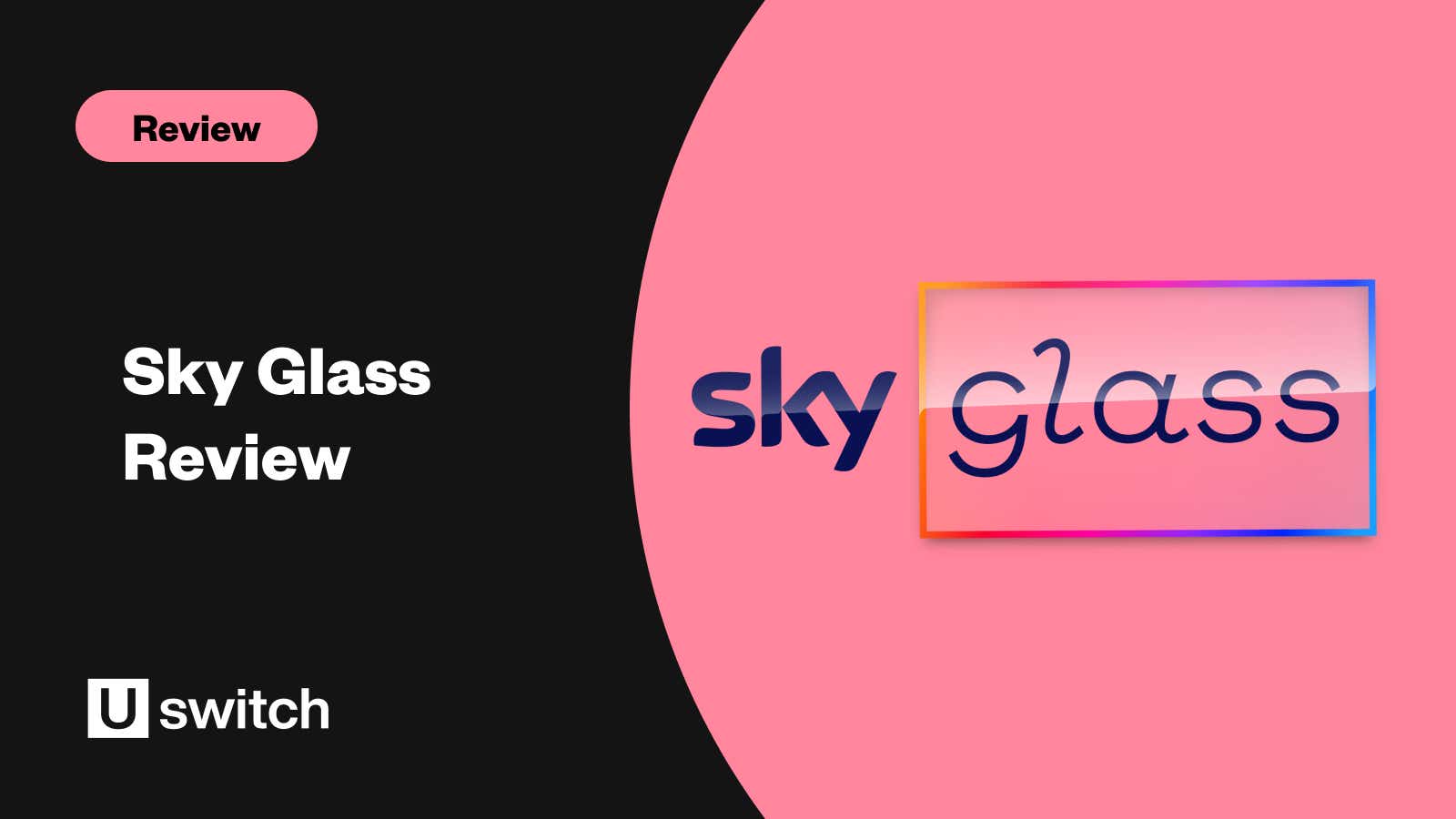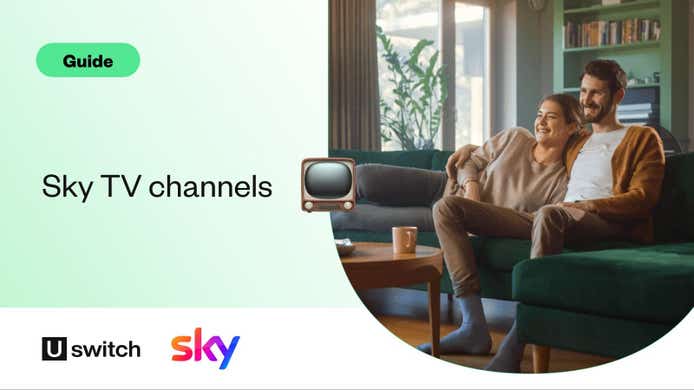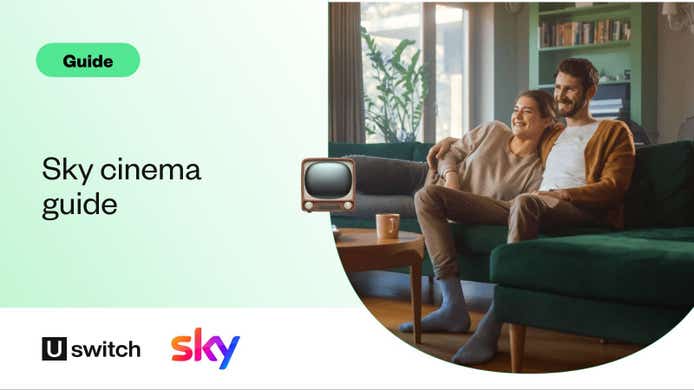Sky has long been a trailblazer in the technology space - with everything from being the leader in delivering high-definition TV content to pausing and rewinding live TV with Sky+.
Sky Glass is on another level and is its big bet on the future of in-home entertainment. It strips away all of the technical hurdles to deliver a simple and elegant solution that brings all you love to watch together in one device.
Doing away with both the dish and set-top box, Sky Glass is not only a premium television with top-class audio but wirelessly connects you to the best of Sky’s original content, as well as the cream of streaming services.
As the "world's first" TV to be CarbonNeutral® accredited, you can be confident that you're buying something efficient, environmentally friendly and built to last.
Is this a new way to watch TV? Read our full review of the original Sky Glass, launched in 2021, to find out.
Sky Glass six months later
Sky Glass has continued to be a great new way to experience content.
The integration of the best streaming services, Sky original content and linear programming into a single entertainment platform still impresses, but it has also seen a wealth of updates in the last six months to improve the core experience even more.
Better ways to watch
A key innovation of the traditional Sky+ box was being able to rewind, record and store live TV, building a library of shows for viewing at one’s convenience.
Sky Glass still includes a vast library of curated content accessible at a moment’s notice - but the shift from saving to streaming is a meaningful difference for those who enjoyed filling up their hard drive with weird and wonderful shows to view later, as you simply can’t do that here.
One of Sky Glass’ big tweaks soon after launch addressed this - introducing ‘Playlists’ to enable quick and easy access to shows that you’d already started watching, and wanted to return to.
This adds a huge amount of value to the all-important home screen, picking up from where you left off on your preferred content far more easily.
In a similar vein, there was also a massive tweak to the TV Guide, creating a separate section in each category to start a show instantly from the beginning as opposed to trawling through nested menus - so no more rifling through box sets!
Drawing currently playing shows to the forefront hugely reduces that all-too-familiar ‘decision paralysis’ in what to watch…a major and meaningful improvement to the Sky Glass experience.

Highly dynamic Formula 1 races with HDR
A significant change was the introduction of High Dynamic Range (HDR) to Formula 1 broadcasts for the 2022 season.
Every pit change, overtake and bid for podium supremacy looks better than ever, with vivid contrasts between colours and richer imagery on live content, in addition to being presented in 4K high definition.
This made Sky Glass - in conjunction with Sky Sports F1 - a great place to watch the fastest show on Earth. It’s important to note, however, that both Sky Sports and Ultra HD come at additional rolling fees to the core Sky Glass package (£25 and £5 per month respectively), but the upgrade for fans is well worth it.
One of the main points raised in our original review was the integration of multiple services into voice activation - something which has been refined over time. Adding a subscription and getting to your favourite service is easier and more integrated - getting closer to Sky’s vision of unfettered access to what you want to watch.
Wired for sound
One of the original complaints I levelled at Sky Glass was that the audio from its in-built Dolby Atmos speakers was decent, but a far cry from that of dedicated soundbar setups.
Another tweak is that there is now a dedicated setup process to get the best output from the onboard audio, making the bass a lot more booming and giving a better all-around aural experience.
That being said, after a launch period where it was decidedly unfriendly with external solutions, with a bit of tinkering it does also play a lot more nicely with the likes of a Sonos or Sony setup.
Perfect for the refined Spotify app on Sky Glass, which can showcase lyrics on-screen for those impromptu karaoke sessions.
Going deeper with Disney and Apple
The lauded integration with your favourite streaming services is a pillar of the Sky Glass experience, and it’s great to see some of those initial teething issues about global search and overall seamlessness when travelling between apps being improved over time.
Apple TV+ has grown into a home of prestige programming. Host to the Oscar-winning original movie CODA and the sci-fi smash hit Severance, its credentials have been more than proven in the months since Sky Glass’ launch.
Seeing its presence front-and-centre is all the more welcome, as well as an introductory offer for Glass owners of three months free (available until 13th May).
Another interesting addition (and potentially a sign of things to come) is the deeper integration with Disney Plus, another fledgling service that has launched with great success. You can use the voice controls to sign up and subscribe directly from the user interface.
Given the deeply interwoven nature of the content showcased on Sky Glass’ home screens, we certainly expect more services to adopt this in the future. Want to watch all the seasons of The Boys but don’t have Amazon Prime? A few words, and you’re in.
As anticipated, Sky Glass shares as much with a modern smartphone as it does a traditional TV, and a raft of fast and frequent updates constantly improves and refines the experience.
Whilst it continues to serve as an entry point into telly technology better suited to the casual consumer over the enthusiast, as an all-in-one entertainment hub with new ways to interact thanks to a Smart Camera on the horizon, we remain excited to see what Sky Glass can do next.
Design and specifications

Sky Glass makes a tremendous first impression, especially given that it’s Sky’s initial effort.
Its clean lines, an array of colours to choose from and the lack of any ‘Sky’ branding on the front showcase the intention for Glass to slip itself easily into any home, complimenting as opposed to becoming the focal point of a room.
Similarly styled to televisions from high-end manufacturers with a flat and angular anodised aluminium frame, it makes things even more exciting when touching the rear of Glass and finding a flexible mesh rather than more metal.
This acoustic mesh also covers the speakers underneath the display and is colour-matched to the rest of the unit by default.
Sky also made Glass its most environmentally friendly product to date. In fact, Glass received a CarbonNeutral® accreditation for the low-carbon production and design materials it used.
In terms of specs, we’re talking fairly high-end but stopping short of some of the latest 2021 technological developments in TV.
The display is a 4K QLED effort that can support Dolby Vision, HLG, and HDR10 with clarity and vibrancy. It offers a maximum 60Hz refresh rate but falls short of technical wizardry like 120Hz and variable refresh rates, so perhaps it is not the first choice for dedicated gamers.
Equally, there are three HDMI 2.1 ports, one of which supports eARC (basically allowing better-quality audio like Dolby Atmos to travel from TV to soundbar).
Delivery
Whilst Sky Glass wows out of the box, the difference starts as early as its (free) delivery – complete with eco-friendly recyclable packaging.
A pair of professionals arrive on the day of your choosing, deftly connecting the integrated stand and placing it in a position of your choice – but only if not wall-mounted, you’re on your own for that one.
The installers also give users the option to keep or have the packaging taken away, for once your living room isn’t a plastic and polystyrene wonderland when getting a new piece of kit. This is clearly a different way of doing things.
Setup

This is another indication that something is a bit different with Sky Glass. After plugging it in, no set-top box means that everything is handled through a single power supply. After a brief booting animation, the menu asks for a Wi-Fi connection to your broadband.
Log in, pair and you’re good to go!
There is also the option to connect directly via an ethernet cable to get started. It’s important to note that Sky Glass works with any broadband provider, you’re not required to be with Sky in order to use Glass.
Logging into each of your streaming apps enables access to the required services, but those shows do all appear on the programme guide regardless. You will need to log in with your Sky account to use additional services such as Sky Store for pay-per-view content and to view your account details.
In terms of broadband speeds required, a minimum of a 10Mbps download connection enables core content, whilst shows in 4K with Dolby Atmos audio need a minimum of 25Mbps to make the most of it – much like existing smart TVs.
One oversight is the lack of profiles for individual people within the home, meaning that one person’s viewing habits could dominate the recommendations algorithm.
Not great if your tastes are meaningfully different from a significant other, or you want to limit access to younger ones. Sky’s content can be pin-protected, but individual apps also need to be set up, as well as the shows remaining visible and recommended on the interface.
Remote Control

Sky Glass uses a single remote control that’s just as all-in-one as the rest of the service – one simple way of navigating both the device and the content within.
A small, backlit remote enables the usual access to channels via a numerical keypad, an options menu offering accessibility modes like subtitles or enhanced sound settings, as well as a directional pad to navigate menus, as well as pausing and rewinding content.
Volume controls and a dedicated button to add shows to your curated playlist make personalisation quick and easy.
A button dead-centre in the remote with a microphone icon enables voice control, now a fairly common addition to smart TVs, but equally impressive is the far-field voice commands. Just say the words “Hello Sky,” and the top of the screen is lit up with a rainbow, and the TV waits for you to say something.
Speak slowly and clearly, and everything from the TV guide to ‘what’s new on Netflix’ is at the tip of your vocal cords.
The simple command of “What should I watch?” brings up a sea of trending programmes, new additions to the various streaming services, as well as your ever-evolving playlist of ‘favourite’ shows.
Lastly, the ability to suggest shows can be activated by simply being in the same room as Sky Glass, with Glance Motion Technology sensing someone in the room, and springing to life with suggestions of things to watch at any time of the day. It is a nightmare to productivity, but a great example of the forethought into the device’s role in the home and effort to integrate it into your life.
Interface

Immediate impressions are that the Sky Glass interface is truly a thing of beauty, iterating on the impressive Sky Q interface and putting many premium televisions to shame in terms of both speed and cohesiveness.
With slick transition animations throughout, there is rarely any lag or stutter waiting for menus to open which is rife amongst rival smart TVs and streaming sticks alike.
Huge high-resolution images punctuate every menu, with smooth visual flourishes when changing between screens and crisp, clear text making the entire interface easy to read.
The most apparent thing is Sky’s bid to end the ‘fragmented’ viewing experience of old with Glass.
No longer is content confined to its own app. The home screen seamlessly displays Disney’s Loki, nestled between Chris Pratt in The Tomorrow War on Prime Video and Dwayne Johnson in Netflix’s Red Notice, with all of them just a button press away.
Provided you’ve downloaded the requisite apps and signed into your streaming services through Glass, this makes for a refreshing vision where you don’t have to worry about figuring out which platform your favourite series is on. It’s all in one place and you can just get down to the business of watching what you want.
Deeper personalisation comes with the playlist. If you want to follow a programme, simply press the ‘+’ button and Glass brings all related content regarding that show into one place, even if it spans multiple streaming services. Pretty amazing and another step towards an integrated viewing experience!
Live channels

An evolution of Sky’s robust content is present and correct on Glass, allowing easy navigation through many familiar channels to be found on the current Sky Q interface.
However, in this transition to a streaming-only model, there are some meaningful gaps in output which see a number of channels not currently on the service.
Some of the familiar shopping stations (QVC, Ideal World) are not currently available on Sky Glass, nor are some of the niche sporting, religious entertainment and international offerings available on Sky’s native service, Freeview or rival platforms.
Major news channels such as CNN International (now exclusive to Sky following its departure from Virgin Media in September), Bloomberg, GB News and Al Jazeera are also nowhere to be found at present.
Potentially a situation that will be addressed over time, but important to highlight that it currently has the feel of a carefully curated, albeit huge selection of Sky’s content to be found on Glass, as opposed to the entire channel guide on Sky Q or elsewhere.
On-Demand content
The streaming nature of Sky Glass is the biggest departure from the likes of Sky Q – moving from a world of saving content onto a massive hard drive, to simply having access to reams of content at your fingertips.
There isn’t storage on Sky Glass in the way that you built up a library on your set-top box. But between the tailored recommendations every time it sparks into life, and the ‘collections’ - carefully grouped by everything from genre to critically acclaimed shows and even a selection of content based on time of year (currently documentaries and movies for Remembrance Day) - it’s perfectly tuned to showcase the best programmes at a moment’s notice.
Saving on your bandwidth, many shows can also be displayed in the format of your choice, with HD, UHD (4K) and UHD with HDR content all split out to your preference.
Parental guides from Common Sense Media also enable films to be clearly marked by a number of themes in an easy-access parent’s guide, so you know just how violent or how many positive themes a movie has, before selection.
Our best Sky TV deals
Want a bigger and better TV package? Check out the latest Sky TV deals on Uswitch.
Apps

Throughout the review, we’ve seen new apps arriving almost daily to Sky Glass, rounding out the vast selection of content on offer.
Many of the popular streaming services are present, complemented by the recent appearance of Apple TV+ which means Glass can deftly act as a single hub for all your entertainment needs.
Other services include music streaming from Spotify and VEVO, a dedicated weather app, fitness apps from Fiit and Peloton, and even an array of classic mobile games like Tetris and Crossy Road, all working slickly within the Sky Glass ecosystem.
Booting an app is just a few seconds, and is the familiar interface experienced on most smart TVs.
Inputs from devices connected via HDMI show up here, meaning everything from game consoles to Blu-ray players end up having their connectivity settings wrapped up neatly within the Sky Glass interface.
One point to note is that Sky’s voice controls don’t tend to work in terms of searching once within third-party apps. You can request a channel and return to linear viewing, but trying to look for ‘Stranger Things’ whilst within the Netflix app delivered no results.
Doing so within the Sky Glass main UI, however, brings up a link to the show on the popular streaming service. This is a minor oversight that can tend to lead to frustration when the experience simply feels a little inconsistent in how it works.
Sky Multiroom
What if you want to watch Sky Glass in a room that doesn’t have a snazzy new television in it? Well, a small device called a ‘Sky Stream puck’ has got you covered.
These dainty devices enable you to watch all of the Sky channels you’re signed up to in other rooms of the home, connecting to your TV via an HDMI cable and expanding your ability to stream throughout the home.
A maximum of six Stream pucks can be used, alongside up to three Sky Glass TVs when subscribed to a ‘Whole Home’ monthly subscription of £10. This is in addition to the one-off fee of £50 for each puck.
Picture and sound quality
Sky Glass is more than serviceable when it comes to the core viewing experience. An Ultra HD (4K) QLED screen available in 43, 55 and 65-inch versions supports many of the latest innovations including HDR 10 and Dolby Vision.
With the right content, an impressive and clear picture is on offer, with all of the richness of visuals you expect from a high-end panel.
Sky’s efforts to deliver its first piece of hardware have tried not to cut corners in order to deliver. With a decent panel with strong backlighting, Sky Glass does a good job of displaying both HD and 4K content but shares the challenges many TVs face with legacy standard definition outputs looking a little grainy.
With dedicated content-dependent modes to reduce smearing during fast-moving programming like sports and display more vivid hues when watching a movie, Sky Glass remains customisable as well as approachable.
Those more inclined to tinker will find specific brightness, contrast and colour manipulation in the advanced settings options, while the auto-enhance mode takes the ambient light in the room as well as the content on the screen to select the correct mode for the situation.
When it comes to audio, Sky Glass is also a real contender, getting rid of the need for a separate soundbar (although they are supported), with six built-in speakers.
Sound is rich and bassy, as these speakers fill a room with separated channels in all directions while also avoiding tinny low notes thanks to an additional subwoofer.
Support for Dolby Atmos audio also improves the experience, meaning that the spatial audio for everything from cinematic blockbusters to delicate orchestral moments is accurately represented, right out of the box.
Watching a Formula 1 qualifying at a high level was a true showcase of Sky Glass’ capabilities, vibrating the room with minimal effort and creating a truly immersive wall of sound – whilst it certainly doesn’t mean we should throw our soundbars into the bin (a dedicated Sonos Arc and Sub handily bested it in terms of both bass and sound separation), adding one is not essential to enjoy a decent audio experience.
Price
The cost of the TV ranges from £649 for the small 43-inch model, £849 for the ‘medium’ 55-inch model, and £1049 for the sizable 65-inch effort.
Remembering once again that all specifications are identical regardless of size, Sky Glass seems an attractive and affordable all-in-one upgrade for your home.
Another way of buying the TV takes a leaf out of the mobile phone market’s book, where Sky Glass can be purchased on either 2- or 4-year interest-free credit agreements, with an upfront cost of either £10 or £20, and between £26 and £42 on the 24-month plan, depending on screen size.
Actually working out cheaper over the long run than purchasing outright, these monthly structures make the outlay of a high-end TV somewhat more digestible.
However, Sky Glass also needs a content subscription to make the most of its channels and features, at an additional cost. For example, Sky Ultimate with more than 200 channels plus Netflix for £26 per month.
Then comes the Ultra HDR and Dolby Atmos pack to get the best from the visuals and audio of Sky Glass, for an additional £5 per month.
Factor in the likes of Sky Sports or Sky Cinema, and you can quickly see bills north of £80 per month to enjoy Glass in the way the provider intended.
One upside is the flexibility of being able to take these plans on a rolling 30-day basis, but as so much of it is integral to the seamless Sky Glass experience, you may well feel you’re missing out without them.
Sky Glass - our verdict
Even in our brief time with the TV, Sky Glass has impressed us. Constantly evolving in its infancy via frequent updates, adding more apps and tweaks almost constantly.
Sky Glass serves as a bold and exciting glimpse into a world of content convergence, bringing the best of competing services into a compelling whole, all the while lowering the barrier to entry for the casual consumer.
For those less technically inclined, opting for an all-in-one experience - all paid for via a subscription model - is an interesting prospect.
That being said, making the most of Sky Glass could be costly on a monthly basis if opting for all the bells and whistles of Ultra HD, and the core visual and audio experience isn’t quite toe-to-toe with the best manufacturers in the space - an admirable initial effort nevertheless.
So it’s an innovative first effort from Sky to forge ahead in the future of TV, and it’ll be interesting to see if this product stops the flow of cord-cutters moving away from their dish and seeking more from their humble telly.
Sky TV deals
Compare our latest Sky TV and broadband deals




